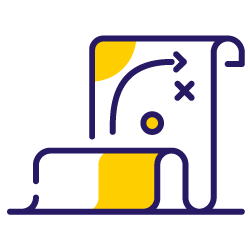Strategy is a roadmap that can (and should) evolve according to the internal & external changes of a company. But it doesn’t have to change every day.
For many, COVID has impacted (and continues to impact) their business, which can obviously impact the strategy to be followed in order to ensure the sustainability and profitability of the company in the long term. For example, do you think that Google, seeing the success of Zoom during containment, did not prioritize the development of Meet to the detriment of other projects in order not to be seen as a poor alternative to the current reference? Given the explosion in remote working, Google could not afford not to improve a product that was essential for teams to be able to communicate.
The travel industry has obviously been greatly impacted by the pandemic. But has Liligo changed its SEO strategy as a result? Yes and no!
COVID and travel
I don’t think I need to explain in detail why COVID has had a strong and lasting impact on the sector in which Liligo operates.
You only have to look at Google Trends data for the main modes of transport to see this in any case.
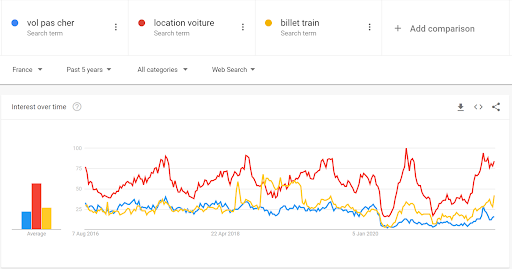
I obviously can’t show you our Analytics or Search Console data, but I don’t think it will surprise you if I tell you that the lockdowns, pandemic and various travel restrictions have inevitably impacted our traffic (and obviously, our revenue).
When you’re dealing with such an upheaval and focusing on the SEO part, do you need to change everything?
What doesn’t change
Before and after the pandemic, a person looking to make a trip will follow broadly the same path. Simplifying reality, the majority of queries can be classified into two broad categories:
Inspirational
This is the set of queries made by users to get inspired. For example:
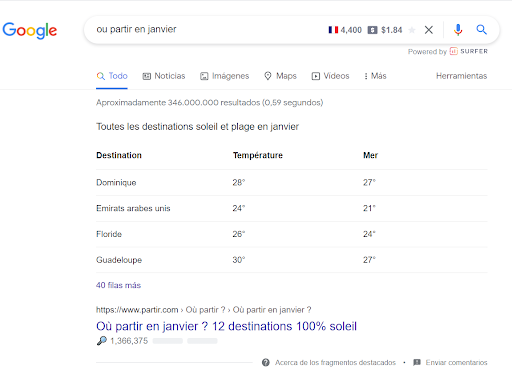
It is crucial for a brand to be able to position itself on this part of the demand because even if the direct conversion is low (the decision process for choosing a destination is long), it allows the brand as well as its services to be exposed as early as possible.
Transactional
Transactional queries are obviously the most competitive because it is on these that the turnover is obtained.
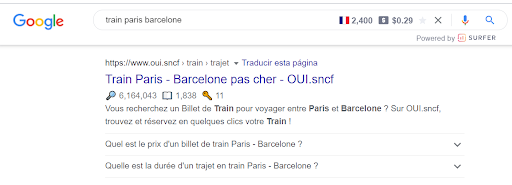
While some destinations, such as Corsica, have become more popular than in the past due to the impossibility or restrictions imposed on leaving the national territory, it was already a popular destination on which many sites are trying to position themselves.

Search volumes (Google Ads) for “flight Corsica”
Even if users’ expectations have evolved, especially on the modification/cancellation part of the booking, the path and the main keywords remain globally the same.
The coronavirus has not changed anything: we want to position ourselves better on these queries. This does not mean that we have not done anything on these pages: one of the most obvious changes is the highlighting of information on restrictions (via FAQ), a detail that is now present on all sites.

What is changing
I obviously didn’t write a whole article just to tell you that we haven’t changed anything :)
Some of our tasks have been impacted by the current pandemic, and I’ll mention the most significant ones in this section.
Internal linking
The internal linking of a site in the travel sector takes into account two main parameters:
- The global importance: is this destination among the most important throughout the year?
- The importance at a given moment: is this destination among the most important at this moment?
An example: if the train journey between Paris and Biarritz is not the most popular throughout the year, it is one of the most popular destinations in summer. It is therefore important that sites wishing to position themselves on the train anticipate the increase in demand with their network.
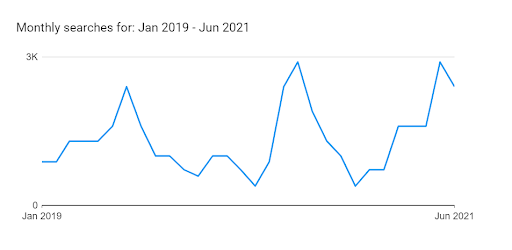
It is therefore common to see on many sites, blocks of mesh that never change over time and others that evolve by anticipating the demand to ensure a correct positioning at the right time. This is exactly what is happening for Black Friday, where internal links start to appear everywhere from October onwards.
Another example: the demand for free tours to Santiago de Compostela (Spain) was in June this year at the same level as in August of previous years.
It is likely that in August the increase will be significant compared to previous years. A logical situation when you consider that many people are moving to nature destinations this year, avoiding the big cities, and Santiago de Compostela is the destination of the famous Camino de Santiago.
If I worked for a company in this sector, I would have already adapted my network to respond to this change in my usual seasonality.

In the case of Liligo, we don’t have the flexibility to change our entire mesh every month, so we decided to define our mesh (using the weighting technique I explained in another article) so that it is adapted to a scenario with and without COVID. This allows us to ensure effective positioning regardless of the evolution of the epidemic.
It may sound strange, but even if the volumes change, the most important destinations are globally the same.
[Case Study] Refine your SEO strategy based on relevant data and granular segmentation
Content
Some of the content generated on the blog has inevitably been impacted by fluctuating demand. Example: traffic generated by a series whose demand is closely linked to the level of air traffic.

This fluctuation does not impact our actions: the keywords are still interesting and we always try to have the best content in order to pick up traffic as the air traffic picks up.
However, with the containment and some changes in user behaviour, new themes have appeared. An example is a theme where the demand is closely related to the inability to travel:

This kind of content had no place on our blog before, but the overall decline in traditional themes as well as the need to expose our brand during a complicated period forced us to change our approach.
And successfully so: the blog is the section of the site that has suffered the least from the decline in traffic in 2020 & early 2021.
Conclusion
The Covid crisis has had a huge impact on the travel sector. The successive lockdowns and restrictions have resulted in a major drop in traffic and bookings.
More globally, it has highlighted the importance of the user intent behind each search. Indeed, even if searches are decreasing in volume, the way of searching remains the same, adding other elements to be taken into account, notably anything related to cancellation conditions or Covid formalities.
The peak of the crisis is behind us, but another question is open: how to deal with this exceptional data in the future? How to build a coherent reporting?
This is the challenge ahead, to know how to interpret the figures for the last few years, while avoiding carrying out classic YoY analyses that would not take into account the changes observed since 2020.
